Card rarity is a very important part of Hearthstone. While some might argue that Common through Epic rarity doesn’t really matter and is just a way to introduce artificial scarcity, the final rarity – Legendary – is different. Legendary cards are special in multiple ways. The cards depict unique, “named” characters (or, more recently, items like Legendary weapons), making them stand out flavor-wise. Given their unique, often very powerful capabilities, they’re also limited to one copy per deck (as opposed to two copies of non-Legendary cards). Every expansion had its own set of strongest and coolest Legendaries, and given that we’re already past 4 years since the first adventure went out (Curse of Naxxramas), it might be the right time to showcase some of the best Legendaries that were ever printed.
Since there are so many of those, I’ve decided to split the article into two parts – one talking about Neutral Legendaries, and the other one about Class Legendaries. I’ve decided to stick with Minions – we’ve already ranked the best Quests, Death Knight Heroes or Legendary weapons, not to mention that it’s pretty difficult to draw a comparison between those Legendaries and the minions.
Important – read before proceeding to the list. When creating this list, I looked at the cards’ overall performance against the field during the time they were in Standard. I’m NOT ranking them on how they perform in the Wild format, and when talking about a card that’s still in Standard, I’m taking both the present and the past into account. For the cards that were nerfed, I’m considering their pre-nerf state (as long as they made enough impact to even be on the list) as well as the post-nerf state. The order of cards is alphabetical, it would be night impossible to objectively rank them.
If you’re looking for the list of Best Neutral Legendaries, check out this article instead!
Honorable Mentions
But first, I’ll start with a bunch of honorable mentions. Those are the Class Legendaries that were close to getting on the main list, but didn’t quite get there. Maybe they weren’t impactful enough, maybe they weren’t relevant for a very long period of time, or maybe despite their strength they haven’t left a lasting impression. It doesn’t mean that they’re bad, oh no. They are mentioned for a reason. 
Al'Akir the Windlord – The first honorable mention goes to Al’akir the Windlord. While it was never as strong as the other Elemental Lord, Ragnaros the Firelord, it was a Shaman staple in multiple decks. Back in the day, it was used in Control and Midrange Shaman, more recently it’s a common card in Even Shaman. It’s not the most outstanding Legendary, but it does its job right – it can be used as either a board control tool or burst finisher (especially when combined with Attack buffs).
Flobbidinous Floop – Floop is the only Boomsday card on this list. Not because the expansion didn’t have good Legendaries, it’s just hard to measure their impact after roughly 2.5 months. But Floop clearly stands out, being the second most popular Druid Legendary after Malfurion the Pestilent and just like the DK Hero, fitting into nearly every build you can imagine. His effect works very well with the combo strategies (copying Malygos or Hadronox), but also as a general way to copy minions with strong effects or Battlecries (e.g. Arcane Tyrant or Giggling Inventor). I feel like he will be the Druid staple until the 2020 rotation.
Grommash Hellscream – The good, old Grommash. Back in the day, I would definitely put him on the Best list, as he was auto-include in Control and Midrange Warrior builds. Commonly used as a burst finisher when combined with an activator (e.g. Whirlwind, second hit of Death's Bite or even Cruel Taskmaster). However, times have changed and Grommash is no longer as impressive as it used to be. He still sees some play in builds like Recruit Warrior or regular Control Warrior (which was mostly pushed out by the Odd version). I think that it might get back into the meta eventually, but it might never be the powerhouse it used to be.
Hadronox – Hadronox was heavily underrated at first, mostly because it was so slow and clunky. But when more and more synergy cards were printed (Dragonhatcher, Sleepy Dragon, Master Oakheart and most importantly Witching Hour + Carnivorous Cube), the card suddenly turned out to be a viable win condition and so Taunt Druid was created. The deck is no longer as popular as it used to be, but you can still meet it on the ladder from time to time, and Hadronox has earned a status of a very scary win condition in certain matchups. 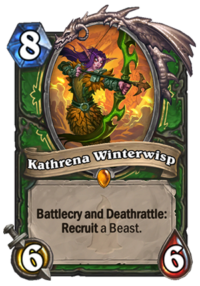
Kathrena Winterwisp – Kathrena was the card that let Hunter go big. Before her, most of the viable Hunter strategies revolved around rushing the opponent down. But since you can pull not one, but two massive Beast cards from your deck, some decks have shifted their priorities and changed their Beast-heavy early game completely, going for cards like Witchwood Grizzly, Savannah Highmane, Charged Devilsaur or even King Krush instead. And so, Recruit Hunter was created. Right now she’s used in Deathrattle Hunter, which has a lower curve, but still runs a few big Beasts to take advantage of her powerful effect.
Lord Godfrey – Solid AoE cards with bodies are always something to look out for, and Lord Godfrey isn’t an exception. To be honest, if we look at the power level of this card in vacuum, it definitely belongs on the Best list. However, since slow Warlock decks haven’t been doing that well lately (other than Even Warlock, which can’t play it), Lord Godfrey wasn’t a very relevant card. However, if you give it a chance, it will shine. You know how powerful Defile can be on certain boards, Godfrey is twice as powerful and comes with a 4/4 body too. While Defiles can be hard to set up and easy to play around, Godfrey absolutely destroys any Aggro or even Midrange decks that want to go for the wide board, and then leaves Warlock with some extra tempo.
Lord Jaraxxus – Lord Jaraxxus used to be to the old Warlock decks what Bloodreaver Gul'dan is to the current ones. It changed your Hero, Hero Power an came with an immediate effect (3/8 weapon). Between the weapon and a Hero Power that summons a 6/6, it was almost impossible to outvalue Jaraxxus in the long run, that’s why the only option was (usually) to just rush the Warlock down. Sadly, unlike Gul’dan, Jaraxxus turned your current and max health to 15, meaning that it was very susceptible to any kind of burst damage or combo. 15 health was still an okay number back in the day, but as burn combos became more and more common, the card turned out to be very situational. Between low health and low immediate tempo (it was much better if you could save a Coin to press the Hero Power right away), you usually needed some sort of board clear immediately after dropping Jaraxxus, and then probably some healing too. Bloodreaver Gul’dan is clearly a better option right now, but Jaraxxus might still make a comeback in the future. 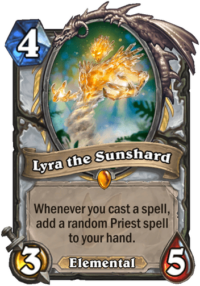
Lyra the Sunshard – Another card massively undervalued by players at first. “It’s not like Priest needs more value”, “5 mana 3/5 body is weak”, “random Priest spells are bad” etc. were the most common reactions to the card, but it turned out to be one of the strongest Priest Legendaries (and maybe Priest cards in general). Priest has a lot of cheap, 1-2 mana spells, so it’s relatively easy to not only start the combos, but also keep up the chain. If you drop Radiant Elemental alongside her and those cheap spells become even cheaper (or free), you can often chain 5+ cards and gain not only a lot of immediate tempo (because the cheap spells are usually doing something, like buffing your minions or clearing something), but also lots of value from the high cost spells you’ve rolled (e.g. Free From Amber or Mind Control). Lyra has been very common sight in all kinds of Priest builds – Control, Combo and more recently Resurrect.
Malkorok – Malkorok was one of those cards that heavily relied on other cards that were present in format at the time. In his case – weapons. When good weapons were printed Malkorok got stronger, and vice versa. When it was first printed, it became sort of a staple in Tempo and Dragon Warrior builds, simply because it was a great mix of value and tempo, exactly what those decks needed. It had a solid body that needed to get answered, but even if it did, you still ended up with a weapon. The average outcomes was something like a 2/3 or a 3/2, which was not bad at all – you either got more damage or more board control. While there were some low-rolls like Light's Justice and especially the Cursed Blade, but on the other hand, you had lots of high-rolls like Gorehowl, Doomhammer or Arcanite Reaper. However, as Midrange Warrior builds have started disappearing from the meta, mostly so did Malkorok. He was still teched into slower Warrior builds like Control or C’Thun sometimes, but it was no longer very common.
Tirion Fordring – If I had to name the best class Legendary back in the Classic, or even during the first expansions, I would most likely pick Tirion Fordring. It is a single card powerhouse – solid body, defensive thanks to the Taunt, hard to get through because of the Divine Shield, and finally, gives you a 5/3 weapon once it died. A great mix of defense and offense, of value and tempo. And it hasn’t seen a lot of play for a while already. It was briefly a pretty common choice in Even Paladin back in The Witchwood, but once the deck was nerfed, it was once again reduced to a solid Stonehill Defender pick. Tirion’s downfall was caused by the general shift in Paladin’s playstyle (it was mostly Aggro or Combo, neither of which really needs Tirion) as well as the popularity of certain cards, like Silence or Transform effects, which counter Tirion quite well. Plus you could just run 2x Stonehill Defender and you got Tirion quite often anyway without actually having to put him into your deck. But I believe that Tirion will eventually be back in the meta, because there is so much of everything packed into this single card.
The Best Class Legendaries Ever
Archmage Antonidas
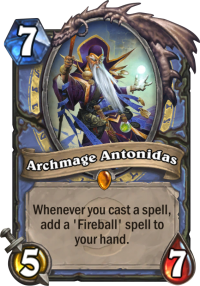
I’m opening this list with the only Mage Legendary which got there (except Kazakus, which is tri-class) – Archmage Antonidas. Why I’ve picked this one out of them all? Well, because he’s been a part of Mage’s identity for a very long time. While not a great meta choice right now, he’s been a backbone of multiple successful Mage archetypes. Back in the day, he was most commonly seen as one of the win conditions in Freeze Mage. He was used to generate extra burn – while what the deck offered was enough in multiple matchups, there were decks against which you simply needed some extra help. Especially powerful in combination with Emperor Thaurissan, you could easily generate 3-4 Fireballs with the right hand.
Later, he has seen some play in Tempo Mage builds as an extra win condition. Tempo Mages were always known for playing a bunch of cheap spells, so they turned them into Fireballs. In a similar way, he was sometimes teched into a Mech Mage around GvG, especially since the deck used to generate some spare parts, one of which has given Stealth (and you know what that meant).
More recently, he was a part of the so-called “Exodia” combo. While the combo itself was possible even before, it got more mainstream popularity thanks to the Open the Waygate Quest – you could play four Sorcerer's Apprentices one turn, play the Quest reward, then drop Archmage Antonidas on your extra turn and start flinging the free Fireballs.
Since the beginning of Hearthstone, Archmage Antonidas was by far the most influential Mage Legendary and one of the most impactful ones in general.
Aya Blackpaw
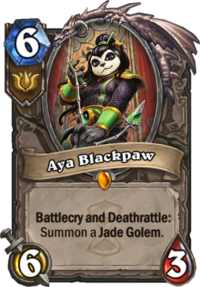
Second on the list is a tri-class Legendary – Aya Blackpaw. Jade mechanic was simple – every Jade Golem you’ve summoned got bigger and bigger compared to the previous one (+1/+1). However, what made Aya Blackpaw stand among other Jade cards was the fact that she summoned not one, but two of them, progressing it by +2/+2 in total. Most of the Jade cards are very slow on the curve, but Aya was different. Even if you’ve just played a single other Jade card before her, she was a 6 mana 5/3 + 2/2, where the 5/3 would Deathrattle into a 3/3. Not the best play ever, but already enough value and tempo to play her. However, it also meant that the next Jade card you’ve dropped would come as a 4/4, probably being a neutral or even a positive tempo play already.
Aya was mostly used in Druid, where Jade was one of the most common archetypes for a few expansion in a row. Hated for the infinite value possibility of Jade Idol, despite not being a Tier 1 deck for the majority of its time in Standard, it was one of the most hated builds in the history of Hearthstone. However, Shamans have also made a good use of her. While a full Jade Shaman wasn’t really viable, “Jade package” of 2x Jade Claws, 2x Jade Lightning and Aya was used in nearly every build. While the first Jade card you’ve dropped was not amazing in terms of tempo, it got better with the second, and great with the third one. Jade Rogue was never a meta thing, although it was an okay off-meta deck if you were into that kind of stuff (Rogue had A LOT of different off-meta decks in the last 2-3 years).
She rotated alongside the Jade mechanic, but she was played basically for her entire time in Standard. While Silence and Transform effects worked well against her, she had no “hard counter” – even if transformed, she still summoned a Jade Golem and made some progress.
Edwin VanCleef

Edwin VanCleef was a Rogue staple ever since I remember. While a 3 mana 2/2 is obviously terrible, it comes with an amazing Combo effect – for every card you’ve played before Edwin, he will get +2/+2. That’s a lot, because just a single card is enough to make Edwin a viable tempo play – 3 mana 4/4 is not likely going to win you the game, but you wouldn’t mind playing it. Just a single more card and he was a 3 mana 6/6, add in another one and he becomes an 8/8. And the best thing about it is that making an early 8/8 isn’t that difficult in Rogue. Turn 2 Coin + Preparation + cheap spell + Edwin is already an 8/8. Such a big body so early in the game meant that Rogue either could put opponent on a quick clock, or could trade into 3-4 different minions before it died (while the Rogue went ahead with his own gameplan).
Edwin was always a powerful card in Rogue – no matter whether you drew him in the early, mid or late game, you could always drop a big body for 3 mana with relative ease. Played in all kinds of Aggro (e.g. Pirate), Tempo and Miracle Rogues, Edwin definitely deserves a spot on the list of best class Legendaries.
More recently, his play rate has declined, mostly because Odd & Quest Rogue are the only two popular Rogue decks, and neither of them really wants to run Edwin. In case of Odd – the deck can’t play 0 mana spells that make it easier to combo it, meaning that it can’t make a big Edwin on the curve (and later in the game it lacks steam to drop a big Edwin), while Quest Rogue has a completely different game plan. However, I’m absolutely sure that once the meta shifts and either a classic Tempo Rogue or Miracle Rogue become better again, Edwin will be back into action.
Fandral Staghelm
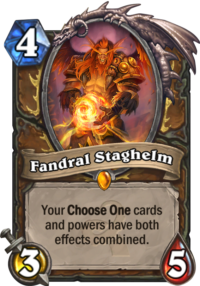
Fandral Staglehm is a card that snowballed more games than I can imagine. Turn 4 Fandral was always a must-kill, if you couldn’t do it, you often just lost the game, because Druid played Nourish on curve, getting both card draw AND Ramp. Even better if he drew Wrath from the Nourish, so he could play it to deal 4 damage AND draw a card for 2 mana.
Druid’s “choose one” cards are already pretty strong because of their flexibility. The fact that Fanrdal let you combine both effects was simply insane – it’s like you’ve played two cards for the cost of one. The Nourish example above basically gave you an extra Nourish that you immediately used for free. It’s like a perfect mix of value and tempo. And the thing is, the longer Fandral was on the board, the harder was to remove him and come back into the game.
But the deck he was scariest in was most likely Jade Druid. Late into the game, when you were running out of cards, you wanted to shuffle more Jade Idols into your deck. It was incredibly slow at first, but Fandral has made it much better. Playing Fandral + Jade Idol + Nourish into one or two more Jade Idols was amazing. Not only you shuffled so many that you probably didn’t have to shuffle again until the end of the game, but you also summoned a bunch of big bodies immediately (at that point, Jade Golems were usually at least 6/6 or bigger).
The fact that he had a solid 3/5 body (almost a vanilla body is definitely solid given his effect) was an icing on the cake. He was by far the best Druid Legendary so far.
Houndmaster Shaw
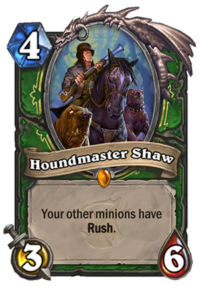
Historically, Hunter Legendaries were always… questionable. Some were too slow for the class, others didn’t fit into any deck, some were just bad. That said, Kobolds & Catacombs and then The Witchwood were amazing for Hunter in that department – first Kathrena and then Shaw. While both of them are amazing, I have to argue that Shaw is even better than Kathrena, that’s why he got to the list of best Legendaries.
Let’s start with the body. 4 mana 3/6 is next to a 4 mana 4/5 the best stat-line you can have (I’d even say that 3/6 is better than 4/5). If you combine the best possible stat-line with an absolutely powerful effect, you will get a single card powerhouse. In a way, he reminds me of Fandral. Both are 4-drops, both have stats (Shaw has +1 health) and both come with powerful ongoing effects, making them a very high priority targets for any opponent. Giving every minion you play Rush is very strong simply because it can give you so much tempo. What’s even better is that you usually play him in a deck with Deathrattle cards, e.g. Devilsaur Egg. Normally, triggering an Egg is not the fastest play on the turn you do it, because you still have to wait a turn to attack with the 5/5. With Shaw on the board, you can Rush him into something immediately. Same goes for Spider Bomb – you can clear one minion with a 2/2 body and another with the Deathrattle just for 3 mana.
Shaw lets Hunter hit the face with minions that are already on the board, and still keep the board control with new minions that are getting Rush. Him sticking to the board can snowball the games so hard, but the best thing is that you don’t have to wait for the right opportunity to play him. Just drop him on the curve, and either force your opponent to remove him (which is not that easy) or get the value. He’s one of the best Legendaries currently in game, and the strongest Hunter Legendary ever.
Kazakus
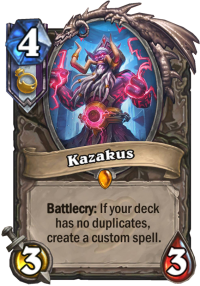
Funnily enough, we’ve got two tri-class Legendaries on the list. Unlike Aya, which was played in 2 out of 3 classes, Kazakus has actually seen common play in all three – Mage, Priest and Warlock. The card was most relevant during the expansion in which it was released – when Reno Jackson was still in Standard. Reno decks were quite popular back then. Even though Warlock was the most popular one, Priest and Mage were also pretty popular and strong. And then, the rotation happened. Once Reno Jackson was out of Standard, no one thought that Kazakus will be relevant again. While I remember Savjz playing off-meta Kazakus Mage every now and then, it wasn’t exactly a Tier 1 deck.
And then, Knights of the Frozen Throne happened and Shadowreaper Anduin was released. Thanks to the combo between DK Anduin and Raza the Chained, a new archetype was created and it was absolutely dominating the meta. While Raza and Anduin were the most notorious Legendaries in the list, and people remember those two, Kazakus was also a very important part of the build. It was an incredibly flexible card – it was a single target removal, AoE removal, life gain, value or even burn damage depending on what you’ve needed. Playing him on T4 against Aggro and getting the AoE won me so many games, but getting 1 mana damage potion was nearly as good in the matchups where you needed more burst (thanks to the Radiant, 0 mana Hero Power and Prophet Velen, the potion was essentially 8 damage for 0 mana).
The deck got nerfed shortly before Raza & Kazakus were meant to rotate out. It didn’t see much play after Highlander Priest was gone, but still, I think that he well deserves a spot on this list for those two times he was a prominent meta card.
Mal’ganis
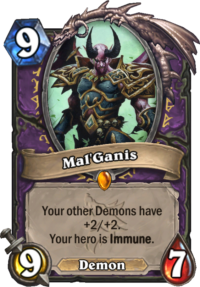
Back to a much older card, one of my favorite cards in the entire game – Mal’ganis. This huge Demon made a massive impact on the Warlock class and has won lots, and I mean LOTS of games. While you might think that he was played only in the slowest decks, funnily enough, for a time he was most popular in Zoo Warlock. 9-drop in Zoo? Were players crazy back then? Well, not exactly, because Voidcaller was a thing. Possibly the most broken Warlock card ever released, Voidcaller let you play a bunch of big Demons in a Midrange Zoo list. The goal was to drop all of the smaller ones (like Voidwalker or Imp Gang Boss), and then let Voidcaller pull out Doomguard or – exactly – Mal'Ganis on death. I remember winning so many games when I’ve dropped a Mal’ganis on T5 with a bunch of other Demons on the board.
Even though the 9/7 body for 9 mana is not necessarily impressive, his effect is one of the strongest ones in the entire game. The part about giving your Demons +2/+2 is already interesting. With 2x Imp Gang Boss and 2x Imp-losion, Warlocks had multiple ways to flood the board with Demon tokens. Dropping Mal’ganis could give you a few great trades or even lethal. But the second part is especially cool – giving your Hero immunity. As long as Mal’ganis was on the board, your Hero couldn’t be damaged at all. This immunity has won me so many matches against Aggro and Combo decks. Against Aggro, they obviously had to first Silence or kill him to get to your life total, but the massive body meant that it was not that easy and you could probably counter-lethal them in 2 turns. And against Combo decks (like Freeze Mage), Mal’ganis could stall the game really nicely. Not only they couldn’t kill you, but they had to waste some of their burn on Mal’ganis. Between him and Loatheb, you could often stall the game long enough to either heal yourself back up or kill the opponent.
Mal’ganis is the only card that could make your Hero completely immune for multiple turns – even Ice Block or Evasion work only for a turn. Between the immunity, solid body, buffing your other Demons and the fact that you could drop him in the mid game with Voidcaller, Mal’ganis was one of the best Warlock cards at the time, and he would most likely still see play in decks like Cube or Control Warlock if he was still in Standard.
Prophet Velen

Prophet Velen is an interesting card. Back in the day, he wasn’t considered an amazing card. That was because Priest was mostly seen as a Control class, not a Combo one. But even then, players have tried to make him work. One of the most notorious attempts was a deck built around the time when Emperor Thaurissan was still in Standard. The goal was to drop Velen, two Mind Blasts and possibly finish everything with Holy Smites. I remember playing it for a while – it wasn’t the best deck at the time, but it was definitely interesting.
However, in the recent few expansions, players have been discovering the Velen’s combo potential. Doubling the damage dealt by spells is not an effect you can ignore, especially in a class which has the best cheap burn spell in the entire game (5 damage for 2 mana). And so, Velen was played in more and more decks. The strongest one was definitely Highlander Priest. After playing the Raza the Chained + Shadowreaper Anduin combo, you had a refreshing 0 mana Hero Power that dealt 2 damage. However, with Prophet Velen on the board, that 2 damage turned into 4, incresing the burst potential tremendously. Throw in a Radiant Elemental and a bunch of cheap spells and 30+ burst damage was very easy to achieve.
More recently, Prophet Velen has been a part of the Resurrect Priest combo deck. The goal is to have minions like Radiant Elemental, Velen or Malygos die on your side of the board, then revive them all at once with Greater Diamond Spellstone. With Maly and Velen on the board, Mind Blasts deal 20 damage each and Holy Smites 14 each, so as you can imagine, it’s not hard to burst your opponent down.
And I’m quite sure that it’s not the last time we’ve heard about Velen. Since he’s a part of evergreen set alongside Mind Blast and Holy Smite, players will make him work as some support cards are in Standard.
Shudderwock
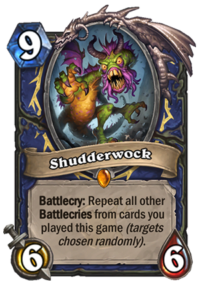
Shudderwock is another quite recent card on the list, but I simply had to put him in there. It’s the card that nearly single-handedly revived the Shaman class, which was down at the bottom for an entire Kobolds & Catacombs expansion. The rotation has killed the only Shaman archetype that was still semi-viable – Evolve Shaman – but luckily for fans of Thrall, a new archetype was here to come. Early days of The Witchwood were all about Shudderwock Shaman. As you can imagine, a card that repeats ALL of your Battlecries can be incredibly strong in the right deck. You could either use him to get more tempo (e.g. Battlecries that summon stuff), more value (card draw etc. Battlecries) or even for the combos. The final use turned out to be the best one. While the deck itself is a bit more complicated, the general idea is to play a bunch of different Battlecry cards over course of the game (Saronite Chain Gang, Lifedrinker, Grumble, Worldshaker) and then make Shudderwock repeat everything. Since Saronite Chain Gang summons more copies of Shudderwock and Grumble bounces them back into the hand (making them cost 1), you can then drop multiple 1 mana Shudderwocks per turn. And given that each one of them will also cast Lifedrinker’s damage Battlecry, it’s a way to slowly but surely kill your opponent.
Because the decks were not optimized yet and players didn’t really know how to play as or against the deck, it created a lot of crazy scenarios, where Shudderwock’s animations could go on for minutes (that was before his Battlecry was capped at 30). The deck’s popularity has plummeted down once people have realized how to play against it properly, but it wasn’t the Shudderwock’s final word. The core of the deck was still strong, it just needed some optimization and a slightly different meta, which was provided by the Witchwood mid-expansion nerf patch. After the nerf patch, Shudderwock Shaman has once again risen to the top of the meta, being one of the most popular and powerful decks for a while.
Fast-forward to Boomsday Project, Combo Shudderwock Shaman is no longer as popular as it was, but it’s still a viable deck. However, a new, quite successful deck was created just roughly 2 months ago, often called Tempo Shudderwock Shaman, or just Ike’s Shaman (from the name of the deck’s creator). It plays Shudderwock deck, but a more tempo-oriented one – it uses him as a massive board refill, as well as a way to repeat a few other powerful Battlecries such as Prince Keleseth‘s one. Both decks are quite difficult to play, but make up for the most of Shaman decks on the ladder. All thanks to the Shudderwock, which will most likely be relevant for as long as there are strong Battlecry cards in Standard.
Sunkeeper Tarim
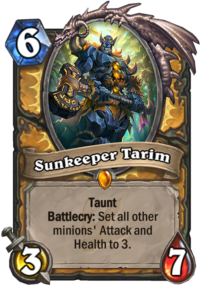
While Tirion Fordring became less and less relevant to Paladin as time went by, a new Legendary was printed back in Journey to Un’Goro, and it quickly became a staple Paladin card played in nearly every deck. Remember the good old Keeper of Uldaman from League of Explorers? Tarim is like a big, mean version of it, coming with a Taunt and targetting everything on the board. As you can imagine, if your opponent has a bunch of big minions (or even a single big minion, to be honest), it can be a massive swing. On the other hand, if you have a bunch of small minions (especially 1/1’s), it can also be a big swing for you. That’s the reason why Sunkeeper Tarim is so popular. If you play a slower deck, you use it mostly as a Control tool, sometimes boosting the damage you have on the board too. And when you play it in a faster deck, you use it as a board-wide buff for your small minions, while sometimes you can utilize it as a Control tool too. That kind of flexibility is what makes it amazing.
Another thing that stands out is the 3/7 body with Taunt, which makes it super awkward to clear. Remember that it turns minions into 3/3’s – if your opponent had three minions on the board and he has no removals in hand (or no ping Hero Power), he might have to use all three of them to punch through the 3/7 body of Tarim. Even tanking two 3/3’s is usually good enough.
Tarim comes handy in nearly every matchup. The only time when he’s unusable is when you’re behind against an opponent who flooded the board with small minions, but that’s not an incredibly common scenario. In 70-80% of the games he will provide a huge, often game-winning tempo swing, and that’s the reason why every time Paladin gets a bit more popular, Sunkeeper Tarim is there to carry games.
He even finds his way into Odd Paladin (which normally can’t play it for obvious reasons), where he’s absolutely terrifying because of the Hero Power. Thanks, Stonehill Defender!
Raza the Chained (pre-nerf)
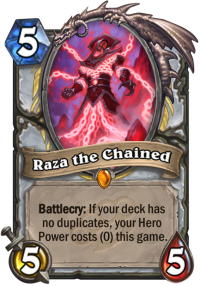
At first, Raza the Chained was merely a solid card. While Reno Priest wasn’t the best deck around during Mean Streets of Gadgetzan, it was okay and had its brief moment of popularity. The card had some extra synergy with Hero Power-related effects, such as Justicar Trueheart or Confessor Paletress. However, once Reno Jackson has left Standard in 2017, the main incentive to play the deck was gone… at least for a while. The card has made a massive comeback during Knights of the Frozen Throne, when Shadowreaper Anduin was released. Noticing the synergy between those two is not difficult – me and lots of other players did multiple theorycraftings even before the expansion was out. However, instead of a more Control-oriented deck that most of players were trying to make, it turned out that the best approach was a cycle-heavy Combo build. You wanted to get those two cards online as quickly as possible, and then start shooting your opponent in the face or just straight up kill him with a huge Prophet Velen combo.
The deck had enough removal, healing, stall tools and value that it quickly became the #1 deck in the meta. It was very hard to counter, and most of the time it lost to itself instead of the enemy – either Raza or Anduin being stuck at the bottom of the deck often resulted in a game loss. However, getting both of them on curve made it nearly unbeatable (and I’m not even exaggerating).
And then, after about 6 months, the card was nerfed. The effect no longer reduced the cost of Hero Power to 0, making all kinds of combos revolving around Shadowreaper Anduin much harder to pull off. I think that it still has seen some Wild play after that, but it was no longer nearly as good as before. To be completely honest, I’m pretty sad about it. I know that the deck was frustrating to play against and unhealthy for the game, but it was probably my favorite deck in the history of Hearthstone.
Closing
Making this list was nearly as hard as the previous one (Neutral Legendaries). Even though Hearthstone is still relatively young when compared to other card games (like MTG), it had its fair share of great content already. Despite some of those cards being too powerful in the end, I think we can all appreciate some strong Legendary options. Those are some of the most memorable cards in the game, and lots of them will see play in Wild format for the years to come.
Do you agree with the list? What cards would you like to see on it? And what are your favorite class Legendaries (not only in terms of power, but also design)? Leave a comment below. Good luck on the ladder and until next time!

Gul’dan > Mal’ganis
Deathstalker Rexxar > Shaw
The caverns below should at least get an honorable mention (nerfed twice?!)
Points off for no dedicated warrior ledgend
All of that is obvious. If you paid attention, the rankings are being separately made for each type of legendary: Hero, weapon, neutral minion, class minion, quest
Yes, but the ranking is for minions only. Quests, Legendary Spells, Legendary Weapons and Hero cards are excluded. We already had a separate DK ranking recently, for example. You can find it here: https://www.hearthstonetopdecks.com/ranking-the-best-death-knight-cards-from-knights-of-the-frozen-throne/
Grommash & Malkorok were honorable mentions, I don’t think that there is a Warrior Legendary that deserves a spot on the main list. Darius Crowley or Rotface would be the closest one to get on the list, but only in the honorable mentions section.
I’ve actually been running Edwin in an odd rogue deck, with surprisingly great results. With coin, turn 3 6/6 or turn 4 8/8 is pretty good.
Perfect world: turn 4, coin+poisoned blade+one-drop+edwin; turn 5, captain greenskin; turn 6, leeroy+cold blood on another drop.
I’ve been playing Edwin in Odd Rogue when the deck was first released, but cut it mostly because it was awkward to play without the Coin. With Coin, it was always great – even on T3, you could Coin + 1-drop + Edwin for a 6/6. But without Coin, you could do a 4/4 on Turn 4 at best, and only if you had a 1 mana card to play. Since you’re going first 50% of the time and then Edwin is not really that great, I’ve decided to play more consistent 3-drops.
But yeah, it just shows how powerful the card is.
At the end you mentioned razakus as one of your favorite decks but was it the OTK variant or the control variant? Because i played the control variant in which i just outlasted the opponent using the free pings to maintain board control or poke the enemy down. It was probably the greediest control deck ever but i loved it so much.
I enjoyed the Control version more, but the Combo one was better, so I’ve mostly played that during my climb. Managed to get to like top 20 Legend with the deck without really trying (I don’t care about high Legend finishes because I don’t collect HCT points anyway) because I’ve played it so much.
I really liked the feeling of having answers to anything, as well as managing your resources combined with 0 mana Hero Power. I know that it often felt frustrating from the other side, but for me it was one of the most fun experiences ever in Hearthstone.
If you mention Shudderwock, you‘ve to mention his bigger brother Master Yogg, too. He was so insanely strong, that he found a spot in nearly every pre-nerf deck as a last option to turn the game.
Liked to read through this article a lot, despite it‘s heavy focus on Standard decks / this year meta.
I‘m missing Yogg, N‘Zoth, Sylvanas, Ragnaros, Alexstraza and Malygos (not in any particular order).
This list is about Class Legendaries, not Neutral Legendaries 🙂 I had one for Neutrals too a week before, you can find it here: https://www.hearthstonetopdecks.com/the-best-neutral-hearthstone-legendaries/
Standard, yes, because that was the focus of this article. But I’ve tried to focus on the previous metas too. Most of the best cards are actually from previous metas – Antonidas, Aya, Fandral, Kazakus, Mal’ganis, Raza. Even Tarim doesn’t see that much play right now and I’ve put it mostly because of how insane he was around Un’Goro / KFT, as well as early Witchwood before the Even Paladin was nerfed.
But let me know if you would rather see other class Legendaries instead, I’ll take it into account if I ever update the list.
To me tarim not seeing play is pretty much a mystery. I still play it in all my paladin decks and he is still so insanly good. Won me countless games and still does that to this day.